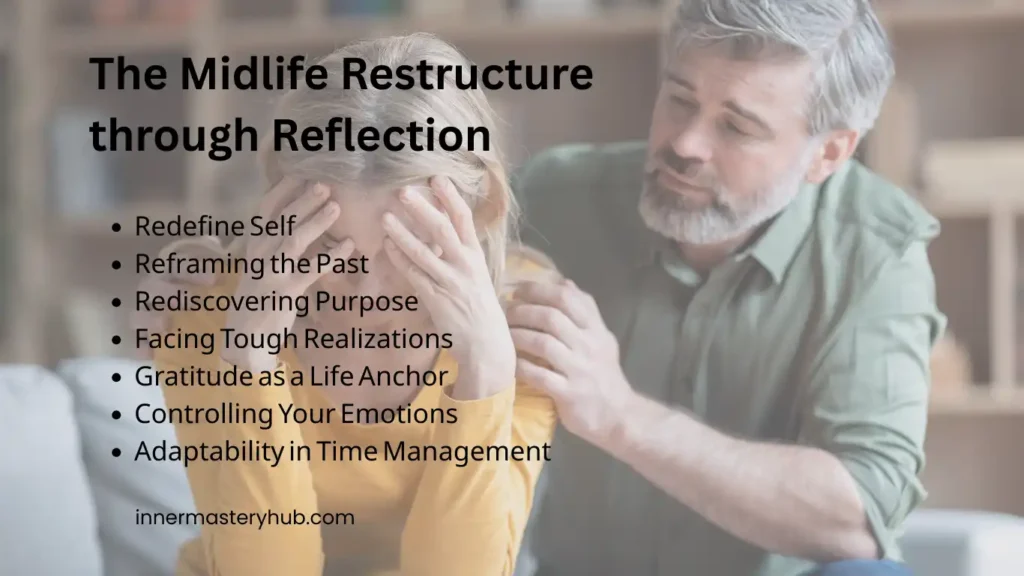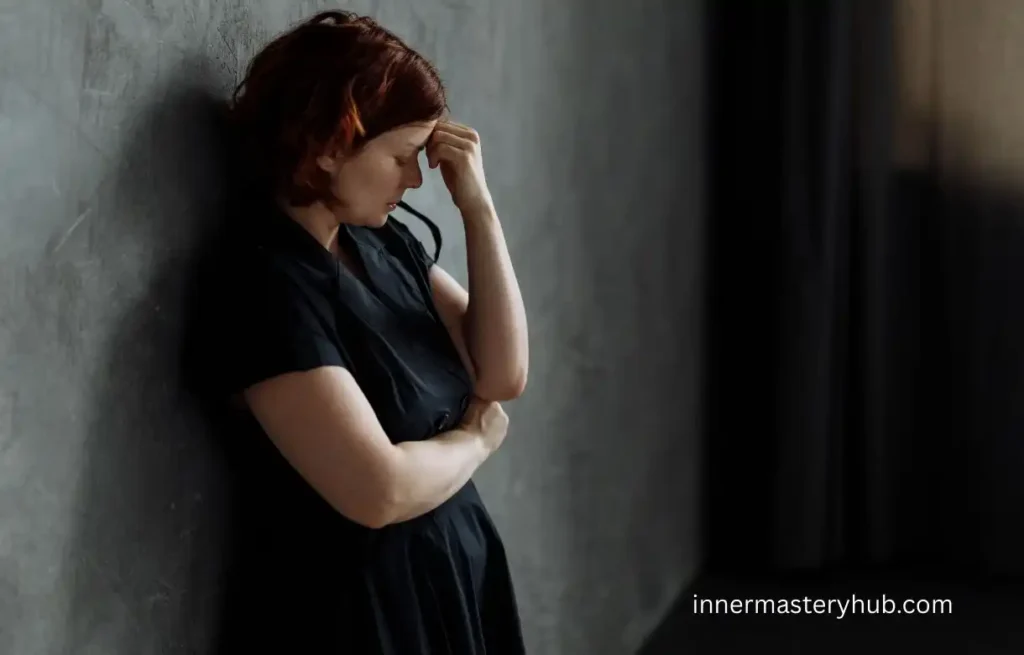Introspection in Midlife Crisis: 11 Ways to Restructure your Life Through

Introspection in Midlife is when you pause and reflect on your journey. You engage in reflection, and that becomes a natural part of this process; you may notice changes in your priorities and question past decisions. Research indicates that approximately 10–20% of adults experience what some refer to as a midlife crisis, but many more engage in quiet self-assessment.
The significance of midlife reflection lies in its ability to provide clarity and purpose. Introspection in midlife, which typically occurs between the ages of 37 and 60, presents an opportunity to balance life’s demands with personal fulfilment.
A Path of Reflection, Introspection, and Restructure
People in their 40s and 50s often experience a sense of unease. Their routine life becomes monotonous, and past achievements appear far away. From raising adult children to caring for ageing parents, the list of responsibilities continues to grow. Physical changes, such as decreased strength or minor health issues, also contribute to the equation.
Based on statistics, happiness follows a U-shaped curve, with the lowest points occurring at ages 47 and 48 in industrialised and developing nations, respectively. This decline is not the result of a sudden breakdown, but rather of compounded pressures.
Many people say they feel stuck due to unmet expectations or financial commitments. According to surveys, 49% of millennials who are approaching middle age feel trapped in their current situation. People run the risk of remaining unhappy if they don’t deal with these emotions.
Why You Find Yourself Rethinking Everything at Midlife
Introspection that reveals expectations versus reality is the source of the problem in question. Career and relationship choices made in childhood may no longer be a good fit. Untaken pathways cause regret. The Midlife in the United States (MIDUS) poll found that middle-aged adults often reconsider their choices, which can lead to emotional turmoil.
Slower metabolism and joint discomfort increase doubts. Women may experience menopause, while men confront work demands. Youth-focused cultures, such as those in Western countries, view ageing as a loss. Research indicates that 15% of individuals experience significant turmoil due to job loss or empty nest syndrome. This reflection leads to isolation if ignored. Social withdrawal strains marriages and friendships.
Fiscal instability exacerbates stress in middle-aged adults from lower socioeconomic backgrounds. Caregiving adds layers—54% of midlife caregivers spend hours daily on unpaid responsibilities, which disrupts both work and personal time. The result? Depression and anxiety are more likely, with well-being plunging before returning.
Factors Contributing to Reflection in Midlife
Life milestones often encourage reflection. As parents age or peers become ill, mortality awareness increases. Who am I outside my roles? Many find career limitations frustrating, especially if promotions stagnate. Family changes, such as children leaving home, create holes. Parenting bills and retirement anxieties increase anxiety. Midlife risk factors also include childhood hardship resurfacing. Their combination creates a perfect storm of unresolved emotions and more profound discontent.
Is it a Crisis or Just Rethinking Everything at Midlife?
Despite evidence to the contrary, society defines this stage as a crisis. According to longitudinal studies, reflection in midlife well-being stabilises or improves in this phase, with declines more related to adjustment than disaster. Psychoanalyst Elliott Jaques coined the phrase “midlife crisis” in 1965, yet only 10–20% of people report having one.
According to Carl Jung, introspection in midlife is an opportunity to rediscover lost aspects of oneself. However, symptoms like restlessness, irritation, or rash decisions continue if the remedy is not received. Divorces peak in this age range, and relationships suffer, and stress-induced inflammation causes health to deteriorate more quickly.
Midlife Crisis Symptoms
Deep sadness, routine boredom, and mood swings are some of the symptoms, though they can vary. Some people undergo bodily changes, such as weight gain or trouble sleeping. Relationship problems or professional modifications may result from others questioning their purpose. It’s imperative to differentiate between depression and crisis symptoms.
Men can focus on their jobs, while women may concentrate on their family responsibilities. There are cultural differences as well; however, they are less common in Indian or Japanese communities. Isolation is made worse by ignoring symptoms; according to polls, 26% of people admit having crises before the age of 40 or after the age of 50.
Causes of Rethinking Everything at Midlife
The following are some common cases when you need reflection in midlife;
Significant Life Changes and Losses
People who experience a midlife crisis often question their life’s purpose, leading to significant life adjustments. Career changes, divorces, and moves are examples of common transitions that can upset relationships and financial security. Impulsive behaviour, such as extravagant spending or reckless behaviours, might result in emotional distress, loneliness, or regret.
While some see the crisis as depression, others discover a sense of renewal. During this critical stage, significant change may be developed, and losses can be avoided with the aid of competent guidance and thoughtful decision-making.
Changes in the Body
You’ve likely noticed a change in the way your body feels. Perhaps the slower metabolism makes it more challenging to maintain your fitness level, or it could be the aches and pains that weren’t there previously. This is a significant step in the process, but it’s also reasonable to feel a bit frightened.
Although it can be annoying, your body is changing, and this presents an opportunity to reconsider how you care for yourself. Perhaps you’re paying more attention to your health than you used to, or maybe you’re simply becoming more aware of your physical limitations.
Transforming Family Structures
It can be challenging to accept the fact that your family situation is likely changing as well. Perhaps the house feels quieter all of a sudden because your kids are moving out or going off to higher education. Or maybe your role in the family is changing because you are taking care of your ageing parents.
Numerous emotions, such as a sense of loss, a diminished sense of need, or even a renewed sense of purpose, might be triggered by these changes. You may start to wonder where you belong in and what your function in the family is now because the dynamics you’ve become used to are different. It’s acceptable to lament these changes while simultaneously embracing the fresh opportunities they present, such as discovering new ways to communicate with loved ones or scheduling personal time.
Career Shifts
It’s normal to begin thinking about your career as you reach midlife. Perhaps you’re wondering if this is all there is, or maybe you’re feeling burned out. It may feel stale at the work that used to give you meaning, and you may question whether it’s time to change. You might be thinking about changing careers, wanting to try something entirely different, or perhaps you’ve hit a stalemate.
Additionally, job stability may seem less secure, which can raise stress levels. Although this time of uncertainty is difficult, it also presents opportunities for innovation. Introspection in midlife can be a period of professional reinvention, whether that means taking on new challenges in your existing position or daringly pursuing something else.
Financial Situation Changes
During a midlife crisis, concerns about one’s financial stability can become a significant source of stress. Retirement may be closer than you’d like, and you may be confronted with the fact that you haven’t saved enough. Or maybe you’re balancing your own future, your parents’ age, and the financial demands of your kids. All of this may cause you to worry about your financial security and future.
While it’s normal to feel uncertain, you may ease some of the stress by reviewing your finances and making plans in advance. You can discover fresh approaches to investing, budgeting, or saving. It might even present an opportunity to explore a side project or career move that aligns with your interests and provides a safety net. The secret is to take charge of your circumstances and make decisions that will position you for future security.
The Restructure through Reflection in Midlife

Transformations Redefine Self
Life changes offer the chance to reinterpret your identity. As you manage changes, you begin to experiment with different identities, values, and ways of being. It’s a process of letting go of the past, accepting change, and coming to terms with who you are becoming—often with more purpose and clarity than before.
Feeling regret and Reassessing Priorities
Introspection in Midlife is an opportunity to reassess previous decisions. Although regrets can arise, they usually inspire a critical reassessment of priorities. It’s an opportunity to reflect on what truly matters and adjust your course to align with your core values and eliminate things that don’t support your evolving self.
Gratitude as a Life Anchor
Being grateful helps one stay grounded throughout times of transition. It enables you to stay grounded in the present and see the positive aspects of your life, despite the chaos. Resilience grows by focusing on what you have rather than what is lacking, which makes it easier to handle difficulties with a positive outlook and greater emotional stability.
Moments of Despair and Turning Points
There are turning points in life—those significant events that change everything. These times of uncertainty and depression are a necessary component of progress. They push you to change how you think, adapt, and overcome obstacles, which eventually leads to new insights and understanding.
Reframing the Past
Reframing the past entails changing your perspective on the past. You can accept mistakes as lessons that helped shape who you are now rather than viewing them as failures. Releasing yourself from the burden of outdated narratives, this viewpoint enables you to move forward with greater empowerment and less regret.
Letting Go and Facing Tough Realisations
Acknowledging that certain things or people may no longer match your path is a common step in the growth process. Although it’s difficult, letting go helps create space for what truly matters. Personal development is made possible by this process, which also creates opportunities for better relationships and self-actualisation.
Finding Calm and Controlling Your Emotions
Maintaining mental health during midlife changes involves managing your emotions effectively. You can keep your composure in the face of change by practising techniques such as deep breathing or mindfulness. You can thrive in times of uncertainty thanks to your emotional resilience, which also helps you make more informed judgments and handle difficulties in a balanced manner.
Creating Family-Friendly and Sustainable Goals
Ensure that your goals align with your values and the needs of your family. This strategy guarantees a long-term equilibrium between family obligations and personal development. Setting goals that are meaningful to all family members fosters a more peaceful and encouraging atmosphere for growth and achievement.
Flexibility and Adaptability in Time Management
Flexibility becomes essential while juggling changing priorities. Adaptable time management enables you to respond to unforeseen circumstances without becoming overwhelmed. You can more successfully balance your obligations to your family, career, and personal life by remaining flexible and not being constrained by strict timetables.
Community and Support as a Foundation
Building a community of support is a solid basis for transitioning and rethinking everything at midlife. Having supportive and understanding people in your life, whether they be family, friends, or coworkers, keeps you rooted. Their assistance makes you more resilient by serving as a reminder that you are not alone in overcoming obstacles.
Finding or Rediscovering Purpose
Finding a new sense of purpose or reestablishing a connection with one’s old one can often be possible in midlife. The pursuit of meaning intensifies, whether via relationships, work transitions, or personal interests. This process involves discovering what genuinely fulfils you, rekindling previously dormant interests, and crafting a life with purpose and direction.
The Psychology of Introspection in Midlife Transition
Midlife is a period of significant psychological change. It’s a time for introspection, reassessment, and development. Although the changes you go through—whether they be relational, emotional, or physical—can be complex, they also present chances for self-awareness and self-reinvention.
You can grow personally and transform your life to align with your evolving ideals and objectives by embracing these changes with an open mind. Introspection in midlife can serve as a springboard for increased fulfilment, purpose, and connection by facing regrets, cultivating appreciation, and adjusting to changing circumstances. The secret is how you handle this shift—realising that although it could be challenging, the path is also replete with opportunities for growth and self-awareness.
Frequently Asked Questions Relevant to introspection in midlife
What is introspection in midlife?
Introspection in Midlife involves in-depth self-examination between the ages of 40 and 60, during which people reassess their values, life decisions, and future possibilities. According to research from the MIDUS project, this period can be emotionally turbulent, but when viewed constructively, it can lead to increased resilience and wisdom.
How does introspection in midlife happen?
Role shifts, such as terminal awareness, and ongoing life experiences, all trigger reflection in midlife. The perspective on time shifts, stressing years left rather than lived, causes people to reassess their priorities and unmet goals.
What are the signs of a midlife crisis?
Mood swings, restlessness, remorse over past choices, and doubting the meaning of life are all warning signs. According to several surveys, 10–20% of adults experience emotional turbulence, characterised by symptoms such as impulsive shifts or boredom with routines (HelpGuide.org).
How to navigate introspection in midlife?
Begin introspection in midlife by writing out your fundamental beliefs and regrets, and then set small, passion-driven goals. While therapy or mindfulness exercises aid in emotion regulation and the development of self-compassion during this shift,
Why is reflection in midlife essential?
Reflection in midlife increases sense of fulfilment, lowers stress, and increases self-awareness. It helps reinterpret experiences, which improves emotional regulation and causes a U-shaped happiness curve to recover after the age of fifty. This makes people feel better overall.
How does introspection in midlife affect time perception?
Midlife is a moment of increased urgency as attention turns from the years past to the time left. This flip inspires self-reflection and shifts priorities to leave a lasting legacy before later life stages.
How to find purpose through introspection in midlife?
Rekindle interests and life-changing events through coaching or mindfulness. With studies showing that narrative reframing increases optimism and purpose, Medium articles advise challenging one’s beliefs and rethinking life, transforming midlife reflection into a time for personal development.
Is a midlife crisis real or just a myth?
It’s true, but exaggerated; only 10–20% go through awful times. Instead of crisis preconceptions, Texas Health says it’s more of a transition for growth, involving self-evaluation that, when handled, leads to positive improvements.
What role does self-care play in midlife reflection?
To ignite inner motivation, Jan Taylor Schultz emphasizes activities like hobbies and rest, which have been linked in studies to a decreased risk of depression throughout the emotional transitions of midlife.
Is it a midlife crisis or depression?
A midlife crisis, which typically occurs in one’s 40s or 50s, involves reflecting on life decisions and often results in impulsive adjustments, such as changes in one’s work or lifestyle. Chronic sadness, low energy, and apathy in life are symptoms of the clinical disorder known as depression. For a precise diagnosis and assistance, speak with a specialist.






